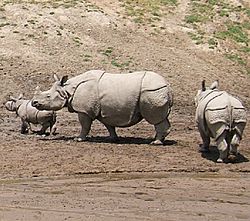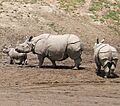Rhinoceros (genus) facts for kids
Quick facts for kids Rhinoceros (genus) |
|
|---|---|
 |
|
| Indian rhinoceros (Rhinoceros unicornis) | |
| Scientific classification | |
| Kingdom: | |
| Phylum: | |
| Class: | |
| Order: | |
| Family: | |
| Genus: |
Rhinoceros
Linnaeus, 1758
|
| Species | |
Rhinoceroses are amazing, large mammals known for their thick skin and, most famously, their horns. The word "rhinoceros" comes from Greek words meaning "nose horn." The genus Rhinoceros includes two types of rhinos that have only one horn: the Indian rhinoceros and the Javan rhinoceros. These incredible animals are found in Asia and are sadly very rare today.
Contents
Discovering Rhinoceroses
Rhinoceroses belong to a group of animals called Perissodactyla, which means "odd-toed ungulates." This group also includes horses and zebras! They are known for walking on their toes, which are covered by hooves.
What Makes Them Special?
The most unique thing about the Indian and Javan rhinos is their single horn. Unlike the horns of cows or deer, a rhino's horn is not made of bone. Instead, it's made of keratin, which is the same material as your fingernails and hair! This horn grows from their snout.
Skin and Size
Both Indian and Javan rhinos have thick, gray-brown skin that looks like armor plates. This skin is very tough and helps protect them. Indian rhinos are quite large, weighing up to 2,500 kilograms (about 5,500 pounds) and standing about 1.8 meters (6 feet) tall at the shoulder. Javan rhinos are a bit smaller but still very big animals.
Indian Rhinoceros
The Indian rhinoceros (Rhinoceros unicornis) is also known as the greater one-horned rhinoceros. It is one of the largest land mammals in Asia.
Where They Live
Indian rhinos mostly live in the grasslands and forests near rivers in parts of India and Nepal. They love to spend time in water, often wallowing in muddy pools to cool down and protect their skin from insects.
What They Eat
These rhinos are herbivores, meaning they only eat plants. Their diet mainly consists of grasses, leaves, fruits, and branches. They use their prehensile (grasping) upper lip to grab and pull plants into their mouths.
How Many Are Left?
Thanks to strong conservation efforts, the number of Indian rhinos has increased. However, they are still considered a vulnerable species. This means they need continued protection to survive in the wild.
Javan Rhinoceros
The Javan rhinoceros (Rhinoceros sondaicus) is one of the rarest large mammals on Earth. It is critically endangered, which means it is very close to extinction.
Where They Live
Javan rhinos are found in only one place in the world: Ujung Kulon National Park on the island of Java in Indonesia. They prefer dense rainforests, often near muddy rivers and swamps.
What They Eat
Like their Indian cousins, Javan rhinos are herbivores. They eat a wide variety of plants, including shoots, twigs, leaves, and fruits. They also use their pointed upper lip to grasp their food.
Why They Are So Rare
There are fewer than 80 Javan rhinos left in the wild. Their numbers dropped dramatically due to hunting for their horns and the loss of their forest homes. Protecting their last remaining habitat is extremely important for their survival.
Conservation Efforts
All species of rhinoceroses face serious threats, mainly from poaching (illegal hunting) for their horns. Rhino horns are unfortunately valued in some traditional medicines, even though there is no scientific proof they have medicinal benefits.
Protecting Rhinos
Many people and organizations around the world are working hard to protect rhinos. These efforts include:
- Anti-poaching patrols: Guards protect rhinos from hunters.
- Habitat protection: Creating and maintaining safe areas for rhinos to live.
- Community involvement: Working with local people to help them understand why rhinos are important.
- Education: Teaching people about the importance of saving these magnificent animals.
By learning about rhinos and supporting conservation, you can help ensure that these incredible creatures continue to roam the Earth for future generations.
Images for kids
See also
 In Spanish: Rhinoceros para niños
In Spanish: Rhinoceros para niños


